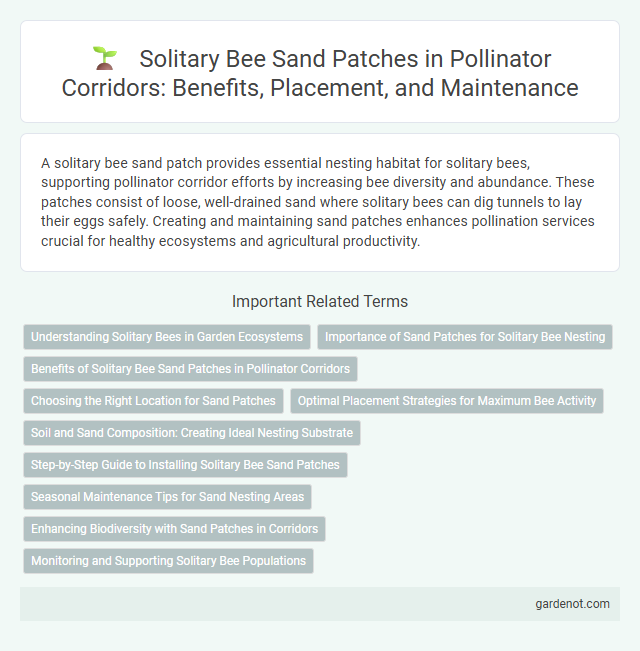A solitary bee sand patch provides essential nesting habitat for solitary bees, supporting pollinator corridor efforts by increasing bee diversity and abundance. These patches consist of loose, well-drained sand where solitary bees can dig tunnels to lay their eggs safely. Creating and maintaining sand patches enhances pollination services crucial for healthy ecosystems and agricultural productivity.
Understanding Solitary Bees in Garden Ecosystems
Solitary bee sand patches provide essential nesting habitats that support the biodiversity and pollination services of garden ecosystems. These bees independently excavate tunnels in well-drained sandy soil, enhancing soil aeration and plant pollination efficiency. Creating and maintaining sand patches can significantly boost local solitary bee populations, contributing to healthier, more productive garden environments.
Importance of Sand Patches for Solitary Bee Nesting
Sand patches provide essential nesting habitats for solitary bees, which rely on loose, well-drained soil to dig tunnels for their offspring. These habitats support biodiversity by enabling various solitary bee species to establish nests safely, promoting pollination in surrounding ecosystems. Conserving and creating sand patches within pollinator corridors enhances solitary bee populations and maintains healthy plant-pollinator interactions.
Benefits of Solitary Bee Sand Patches in Pollinator Corridors
Solitary bee sand patches provide essential nesting habitats that support biodiversity within pollinator corridors by offering safe, undisturbed spaces for ground-nesting solitary bees. These patches enhance pollination efficiency for native plants and crops, thereby boosting ecosystem services and agricultural productivity. Integrating solitary bee sand patches into pollinator corridors strengthens pollinator populations and promotes sustainable environmental health.
Choosing the Right Location for Sand Patches
Selecting the optimal location for solitary bee sand patches requires well-drained, sunny areas with sparse vegetation to ensure easy access and suitable nesting conditions. Ideal sites often include south-facing slopes or open garden beds where temperature regulation supports brood development. Avoid shaded or overly compacted soils, as these hinder solitary bees' ability to excavate nests and decrease patch effectiveness.
Optimal Placement Strategies for Maximum Bee Activity
Strategic placement of solitary bee sand patches in well-drained, sunny locations with minimal foot traffic significantly enhances bee nesting success and activity levels. Incorporating patches near diverse flowering plants within 300 meters optimizes foraging efficiency and supports pollination networks. Properly oriented south-facing slopes improve warmth retention, encouraging early-season bee emergence and sustained colony health.
Soil and Sand Composition: Creating Ideal Nesting Substrate
Solitary bee sand patches require a well-drained, sandy soil composition with a balance of fine and coarse particles to enable easy excavation and stable tunnel formation. Incorporating mixed sand and loamy soil enhances moisture retention while preventing compaction, providing an optimal nesting substrate for solitary bees. The presence of organic matter and minimal clay content ensures suitable aeration and structural integrity, crucial for successful nesting and brood development.
Step-by-Step Guide to Installing Solitary Bee Sand Patches
Creating a solitary bee sand patch begins with selecting a sunny, dry area with well-drained soil to mimic natural nesting habitats. Dig patches approximately 12 inches wide and 6 inches deep, filling them with a mix of sand, fine gravel, and loam to provide ideal conditions for ground-nesting bees. Regular maintenance includes cleaning debris annually and ensuring the patch remains free of vegetation to support solitary bee populations effectively.
Seasonal Maintenance Tips for Sand Nesting Areas
Seasonal maintenance of solitary bee sand patches involves removing debris and loosening compacted soil in early spring to ensure optimal nesting conditions. Avoid using pesticides and keep the area free from excessive moisture to prevent mold and fungal growth. Regularly monitor site exposure to sunlight, as solitary bees prefer warm, dry, and well-ventilated sand nesting habitats for effective pollinator corridor support.
Enhancing Biodiversity with Sand Patches in Corridors
Solitary bee sand patches within pollinator corridors create essential nesting habitats that significantly boost local biodiversity by supporting diverse bee populations. These specialized sandy areas facilitate brood development for solitary bees, increasing pollination efficiency across connected ecosystems. Integrating sand patches strategically enhances habitat complexity, promoting resilient pollinator communities vital for ecological stability.
Monitoring and Supporting Solitary Bee Populations
Solitary bee sand patches serve as critical nesting habitats that support diverse solitary bee populations by providing optimal soil conditions crucial for their reproductive success. Monitoring solitary bee activity in these sand patches through regular surveys and population tracking enables accurate assessment of species diversity and health. Effective conservation strategies, including habitat preservation and minimizing pesticide exposure, enhance solitary bee survival and bolster pollination services within pollinator corridors.
Solitary bee sand patch Infographic

 gardenot.com
gardenot.com